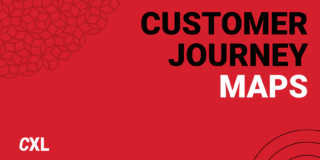Conversations with prospects or customers can improve practically every metric or user state model you’re aiming for.
As Jen Havice noted here on the CXL blog, insights from customer interviews can:
- Accelerate the customer journey;
- Increase conversions;
- Drive more leads, sales, and revenue.
To do that, you don’t need to reinvent the customer interviewing wheel. You can use proven frameworks, like the Jobs-to-Be-Done (JTBD) approach. The JTBD approach is a simple but powerful way to extract ultra-valuable Voice of Customer (VoC) data.
That data, in turn, can help optimize copy throughout your site—as long as you know what you’re looking for before you start your interviews.
With that in mind, this post has three parts:
- How to define needs and goals for customer interviews;
- What Voice of Customer data from interviews will and won’t accomplish;
- How to run Jobs-to-Be-Done interviews to gather Voice of Customer data.
Table of contents
1. Before you start interviewing, define your goals
The goals for a customer interview help structure your questions. They also help you understand what to look for as you dig through interview transcripts.
Any of three methods can help you define those needs and goals before you start talking to prospects or customers.
Method #1: The four helpful lists
The Four Helpful Lists is a deceptively simple planning method developed by Tom Paterson, strategist and creator of The Paterson Process.
How deceptively simple? Pick a problem or opportunity facing your organization and answer the following four questions:
- What’s right?
- What’s wrong?
- What’s missing?
- What’s confused?
Similar to a brainstorming session, the more you answer, the more you’ll clarify and uncover. Genuinely (formerly Mack Web) ran a Four Helpful Lists exercise to improve reporting:
Their resulting flip chart was a mess, but the scribbles and arrows created a clear roadmap for improvements.
Under “What’s Missing?,” they felt they needed to survey their customers. And from other columns, they were able to define exactly what they needed to ask those clients:
- Preferred reporting format and length;
- What they found valuable from the reports;
- What they need from their reports.
Method #2: Use the stages of awareness
Messaging needs to meet your prospects where they are, or as Eugene Schwartz broke it down, at their respective “stage of awareness.”
When a prospect encounters your copy, they’re at one of five stages of awareness:
- Unaware. They don’t know they have a pain.
- Pain Aware. They’ve identified a pain.
- Solution Aware. They’ve found options to solve their pain.
- Product Aware. They’re aware that your product can solve their pain.
- Most Aware. They understand exactly why your product is a choice solution to their pain.
If you’re working to align your copy with the buying journey, you can set up your interviews to discover the journey:
- What is the pain you solve?
- How do prospects discover their pain?
- What solutions do they consider?
- Why do they choose your product, etc.?
Method #3: Plug in to a formula
If you already have a copywriting formula, you can run interviews that mine the data you need to fill that formula.
Let’s say you’re using the Pain, Agitation, Solution copywriting formula to structure your copy (and you probably should).
First, you introduce the pain your prospect is experiencing. Then, you dig in the knife. Finally, you present the solution, which happens to be your product.
Here’s how you find holes that customer interviews can fill:
- Pain. What’s the problem—not the product they’re looking for, but why they’re looking for one?
- Agitation. How does that pain present in specific, gory detail?
- Solution. How does your solution solve their problem? What is the exact tipping point that convinced them?
Once you understand what you need to fill your formula, you can create an interview script that addresses the key points.
Which words do you really need? Those that come directly from interviewees’ mouths.
2. What Voice of Customer data will (and won’t) accomplish
In a groundbreaking report in Marketing Science, Abbie Griffin and John Hauser institutionalized the Voice of Customer methodology and gave it four aspects:
- Customers’ wants and needs—expressed in their own words;
- Organized by hierarchy;
- Organized by priority;
- Organized by customer segment.
Though Griffen and Hauser gave VoC research clear parameters, many misunderstand it to mean asking the customer what they want. As Gerry Katz of Applied Marketing Science notes,
A common amateur mistake, ironically, is to ask the customer, ”What do you want?” [. . .] the customer assumes that they are supposed to describe the exact feature or solution they want. This approach confuses needs with solutions to those needs.
Contrary to popular belief, VoC does not intend to turn over innovation to the customer. Katz continues:
[A]ny researcher or product developer who has ever tried this approach understands its futility. Why? Because most customers aren’t very good at coming up with innovative solutions. And frankly, that’s not their job – it’s yours!
VoC research isn’t about asking your customers what they want but digging to find that answer yourself. Customers may not know what they want in a product, but they do know what they want in business or life.
By asking customers about their pain, motivations, objections, etc., you discover what they need in a product. Incidentally, these insights give you the exact copy and hierarchy to help other prospects decide to purchase.
VoC data has won conversion lifts over and over again—for Beachway rehab center, Sweatblock, LearnVisualStudio.net, and others. Some even argue that VoC research is the only way to write high-converting copy.
Why does it work so well? It speaks the words that often go unspoken.
VoC copy taps into (unspoken) consumer emotions
When I wrote the evergreen funnel for the Copy Hackers 10x Freelance Copywriter course, I hesitated over the last email. The subject line? “You are a weirdo.”
Not exactly a safe subject line. But it came from the customer. It came from a social anxiety. And it was a powerful driver. Here’s the quote from the customer interview:
So I do think it would be just really cool to meet other people who have that same like connotation of like the weirdos, but they’re not. Or if they are, it’s in a good way. It’s because there’s something right with us, not wrong with us.
There’s a reason we squirm when we imagine someone reading our mind. In our minds, we’re safe to be vulnerable, weak, doubtful. When you put all this onto the screen—in conjunction with your product—it feels risky.
But risky copy is usually a sign you’re doing something right. Taking a risk differentiates you in the customer’s mind—and shows that you have a unique way to solve their problem.
As Joanna Wiebe noted in her talk at CXL Live, a “breakthrough or bust” approach to copywriting encourages risk-taking. (The campaign with “You are a weirdo,” isn’t live yet, but it has that “breakthrough or bust” potential.)
Ultimately, when you use VoC data, you help the prospect feel understood. And when the prospect feels understood, you earn loyalty: validation motivates connection.
How do you get that VoC data from interviews? The Jobs-to-Be-Done framework is an effective approach.
3. How to run Jobs-to-Be-Done interviews to gather VoC data
Job theory is the belief that people “hire” products to fulfill a “job.” The classic Jobs-to-Be-Done case is the prospect who walks into Home Depot to find a power drill.
If you look at her search through the lens of a product as a job, you understand that she’s not looking for a drill. She’s looking for a way to make a hole in her wall. Which means she’s really looking to hang a picture. Which means she’s looking to make her house look nice.
Where you’d once focus on power tools, jobs theory instead focuses you on hanging solutions. That’s allowed for massive disruption and innovation. Because when you let go of the traditional theory of “the prospect wants to buy a drill,” you let go of “traditional competitors.”
Now, suddenly, you can introduce this prospect to other hanging solutions like self-adhesive heavy-load hooks, or even a kitschy spread of yarn and binder clips.
JTBD interviewers don’t start an interview with questions about the product but instead ask to hear about the journey behind the purchase. (If you want sample scripts for JTBD interviews, see this one or this one.)
They’ll often ask the interviewee to imagine themselves as a subject in a documentary—to give the full, vivid story surrounding the decision and purchase experience.
This method allows for a more truthful—and thorough—account. It dives into the decision-making process instead of focusing solely on the customer’s satisfaction or dissatisfaction with the product.
The JTBD framework is essential to uncovering VoC data. But remember, the full method is all about the job. Not the motivations, not the backstory. When you run a JTBD interview, you uncover those things, but according to the traditional model, their only importance is getting you to the job.
So, when interviewing for VoC insights and copy optimization, use (most of) the framework, but shift the focus. Here are five elements of the framework to follow—and three to avoid.
5 essential elements of the JTBD interview framework
Five elements of the JTBD framework fit perfectly into a customer interview that’s focused on uncovering qualitative insights to improve copy and increase conversions:
1. Be human. Use natural language—this is a conversation. You’re uncovering a story, not an academic thesis. You’re also looking to uncover sensitive information. Your interviewee needs to feel comfortable being vulnerable.
2. Be curious. Curiosity encourages authenticity and storytelling. Curiosity is what allows for discovery. NYU Professor Carol Gilliagan explains:
Students always ask me: “So when I do the interview, what should I ask?” And I say: “That’s the wrong question.” I always say: “You have to have a question that you are really interested in. Not make it up, but find out what you are really interested in.”
3. Be biased. When you agree with your customer, when you egg her on, you make her comfortable. You allow her to trust you and open up to you. Be careful not to ask leading questions, but don’t be a completely impartial, detached interviewer.
4. Use context reinstatement. Originally used by detectives to allow witnesses to better remember crime scenes, context reinstatement is a Cognitive Interviewing method that takes the interviewee back to a moment in time.
Questions surrounding the senses of the moment—what was the weather like, what you were wearing, who were you with—allow the interviewee to re-experience the moment and give a more accurate (and emotional) account.
5. Stay factual. JTBD interviews are centered on true accounts only. There is no room for speculation or theoreticals when discussing decisions, features, or outcomes. Speculative “data” won’t lead to higher conversions.
3 elements of the JTBD framework to ignore (or use sparingly)
There are three elements in the JTBD framework that are less effective for uncovering copy insights:
1. Notetaking. JTBD interviewers take unique notes. They draw a customer journey map and note each statement in the corresponding slot of the customer’s journey. They do this during the interview to help direct their line of questioning.
The challenge with notetaking is that it can easily become a distraction. For marketers hoping to improve copy (rather than develop products), we should focus on the conversation and take only margin notes.
Remember: We’re digging for exact customer language. Yes, information about the journey can be useful, but the goal is the rich VoC language that will resonate in the prospect’s head.
There’s no way we can note exact language and focus on the conversation. Instead, record the interview (with permission), get it transcribed, and then organize the notes, post call.
2. Two-on-one interviews. The JTBD framework also suggests interviewing in pairs, for two reasons:
- Two sets of notes. But you’re not taking detailed notes, remember?
- Faster pace. When one interviewee is processing information shared, or developing the next line of questioning, the other interviewer can jump in with more questions. But silence is an incredible way to access vulnerable, deeper insights. As Michael Bungay Stainer suggests,
Silence is often a measure of success… it means [your interviewee is] thinking, searching for the answer. He’s creating new neural pathways, and in doing so literally increasing his potential and capacity.
Asking “Why?” JTBD interviewers love asking, “Why?” They need to dig, dig, dig to the bottom. But you don’t need to ask “Why?” to learn why. And in fact, according to neuroscience, you shouldn’t. Kay White explains:
Why [. . .] does two things very quickly, immediately in fact; two things you want to avoid: 1) it sends people straight to the word “because” which is justifying their actions or decisions; and 2) it closes down information-gathering in the request for “the reason.”
There are a few other reasons, too:
- We buy on emotion and justify with logic. Ask “Why?” and you’ll get a justified, logical reason—which may be inaccurate.
- Asking “Why?” moves a customer from an emotional space to a cognitive space. Barriers and motivations are backed by emotion. We want to stay in the emotional space because we want our prospects to tap into those same emotions.
- Why puts us on the defensive. Again, we need the interviewee to feel as comfortable as possible, so turn “Why?” questions into “What?”questions:
- Why did you do that? >> What was the thought process behind that decision?
- Why did you feel that way? >> What was feeding into those emotions?
- Why were you looking for an X product? >> What was going on in your life that led you to search for an X product?
Conclusion
Conversations with customers are a rich resource that reach beyond product development. The JTBD framework can help customer interviews deliver rich VoC data to improve low-converting areas of your copy.
To get started:
- Pick a method to define what you hope to gain from your customer interviews.
- Set up interviews with customers who will help you get that information.
- Listen for their story—really listen—and record their insights (digitally) to review later.
- Identify emotionally charged language that relates to the pain they’re experiencing—and the “job” they need to “hire” a product to do.
- Apply those insights in their raw, exact language to your weakest copy sections.





Bookmarked. Super high quality post!
Thanks for reading – glad you got value!
I love how you broke this down – and mixing JTBD with some of the rock solid marketing and copy principles is SO smart. I’m bookmarking this one for reference – it’s an incredible resource (in one article!). Great stuff.
It’s so cool how when something works, it works across the board – no?
Saving this one! Thanks for digging into all the most important parts with such clarity. Looking forward to upgrading my next interviews.
You’re so very welcome :). Good luck with them!
You’ve crammed so much good info in here Nikki, yet it’s super clear and concise. Great work!
I’m with you on the edgy email subject lines taken from voc – I’ve seen more controversial lines get good open rates. I’d be fascinated to know how the “You are a weirdo” subject line performed relative to the others in the sequence…
Thanks, Liz.
Can’t wait to find out too…